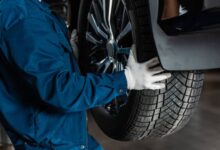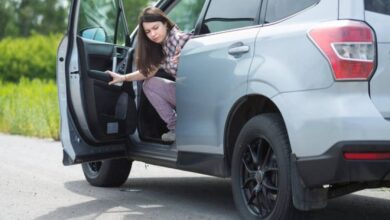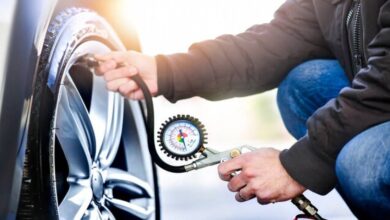How To Check Car Tire Pressure Without A Gauge?
Last Updated on August 1, 2023 by Thomas James
Many people need help to check car tire pressure without a gauge. There are many ways a person can check their car tire pressure. This blog will focus on the most common way people do it: looking at the sidewall of their tire.
It’s important to always check the tire pressure before hitting the road because low tire pressure can lead to severe problems.
Although tire pressure is only sometimes on your mind when driving, checking the pressure every week is a good idea.
Additionally, paying attention to any unusual sounds your tires make is essential. You must do this to drive optimally.

How To Check Car Tire Pressure Without A Gauge
After a day of driving, ensuring your car is safe, and sound is crucial. Checking your car tire pressure is not only a good idea, but it’s also easy to do. Check your car tire pressure before you go on a long drive and save yourself the pain of being stranded.
Tires are a very important part of a car, but checking the tire pressure without a gauge can be challenging. Car tires are no exception to this rule.
So, how can you check the tire pressure without a gauge? There are several methods for manually checking the tire pressure in your vehicle. Here are some simple, easy-to-follow steps for checking your tire pressure without a gauge:
Feeling the Tires
One of the most common methods for checking tire pressure without a gauge. It involves pressing the tire with your hand or foot, also known as hand pressure.
It would help if you felt the tire’s sidewall to check your tire pressure. You can feel the tire pressure by pressing on the tire. If you feel a hard spot, the tire is underinflated.
If you feel a soft spot, the tire is overinflated. It is important to check the tires to ensure they are high enough. If unsure, you can always check the pressure with a tire gauge.
Do you also like: How To Use Air Compressor To Inflate Tires
Visual Confirmation
It is a method that requires some patience, practice, and expertise! Checking tire pressure by eye is difficult but not impossible!
Soon, you can confirm that the tire pressure is correct visually. It is a perfect way to check your tire pressure without a gauge.
- The first step to doing this is to make sure your tire is not cracked. Cracked tires are much harder to check the pressure on. Once you are sure your tire is not cracked, you need to look at the sidewall. You can ensure the tire is inflated correctly if the sidewall is smooth and flat.
- If you see a flat tire, it means it is low on pressure. It is important to make sure that the tire is not flat before you drive. If you go on a flat tire, you will be risking your safety and the safety of other drivers.
Loading Weight
Another way to check your tire pressure without a gauge is to load your car with a heavy object.
The first step to doing this is to find a heavy object that you can use to check the tire pressure.
You can use a large rock, book, or anything heavy enough to make a difference in your tire pressure.
Next, you need to load your car with the object. If you notice more than 10% of the tire bulges, it needs to be inflated.
You also like: How Long Can A Car Sit On A Flat Tire?
Driving Experience
When driving, you may experience some signs of low pressure. Several indicators of low tire pressure on the road include steering noise when turning, a rough ride, or steering issues. If you experience these problems, inspect your wheels to avoid any potential issues.
Check PSI Method
Every vehicle comes with a tire PSI number known as Pound Force per Square Inch. This information is available in the driver’s manual or on the driver’s side door.
The number typically represents the minimum PSI(pounds per square inch) at which the tire must be inflated to function properly. You can, however, adjust the PSI as needed.
Sedans and minivans suggested PSI ranges from 26 to 32. However, if necessary, that can be increased to 40.
Ride in Mud Test
The ride-in mud test is a method used to check tire pressure. The test is conducted by driving a vehicle in the mud.
- Mark the tires with a marking material or ink.
- Then, with slight car movement, leave a mark on the road.
- Ensure you do this on a flat surface like a sidewalk or a road.
- Examine the tire tracks that have been created. The observation will provide comparable results on the exhausting amount in contact with the surface.
- Compared to other trails, the trail made with the tire with less air will be scrubbed and different.
- Repeat the test with more air until the required tire pressure is reached.
If you experience these problems, inspect your wheels to rule out any potential issues. In another case, you should contact a mechanic to get a professional opinion.
The Effects of Improper Tire Pressure
As the tire pressure decreases, the tire becomes less capable of maintaining traction. The tire will be less resistant to slippage and will have a lower coefficient of friction. It can cause a vehicle to lose traction and even cause it to spin out.
- If your car’s tires are underinflated, you may lose control. It can also have an impact on tire stability.
- Tires that are underinflated may also cause a vehicle to lose braking power.
- If the tires are underinflated, the driver will be required to apply more force to the brake pedal to stop the vehicle.
- There is a significant risk of tire blowout when driving with inflated tires.
- When tire pressure is low, fuel consumption increases.
Frequently Asked Questions
How do I check my tire pressure?
You can check your tire pressure using a tire gauge or a tire pressure monitor.
Can I drive on low tire pressure?
Driving at low tire pressure is not recommended. The tire pressure should be maintained at a safe and reliable level. If the tire pressure is too low, it may cause the tire to blow out.
What should I do if my tire pressure is low?
If you notice that your tire pressure is low, you should make sure that the tire is not flat.
How do I maintain my tire pressure?
It is recommended that you check your tire pressure at least once a month. It is recommended that you check your tire pressure before you start driving.
What are the symptoms of low tire pressure?
There are several symptoms of low tire pressure. You should check your tire pressure if you notice any of the following.
- Steering noise when turning
- Rough ride
- Steering issues
Final Verdict
We hope you enjoyed our blog post about how to check car tire pressure without a gauge. Take the time to check your car’s tire pressure by using a few different methods.
You might not think about it now, but when you’re driving in winter, you’ll want to double-check to make sure your tires aren’t getting too low.







